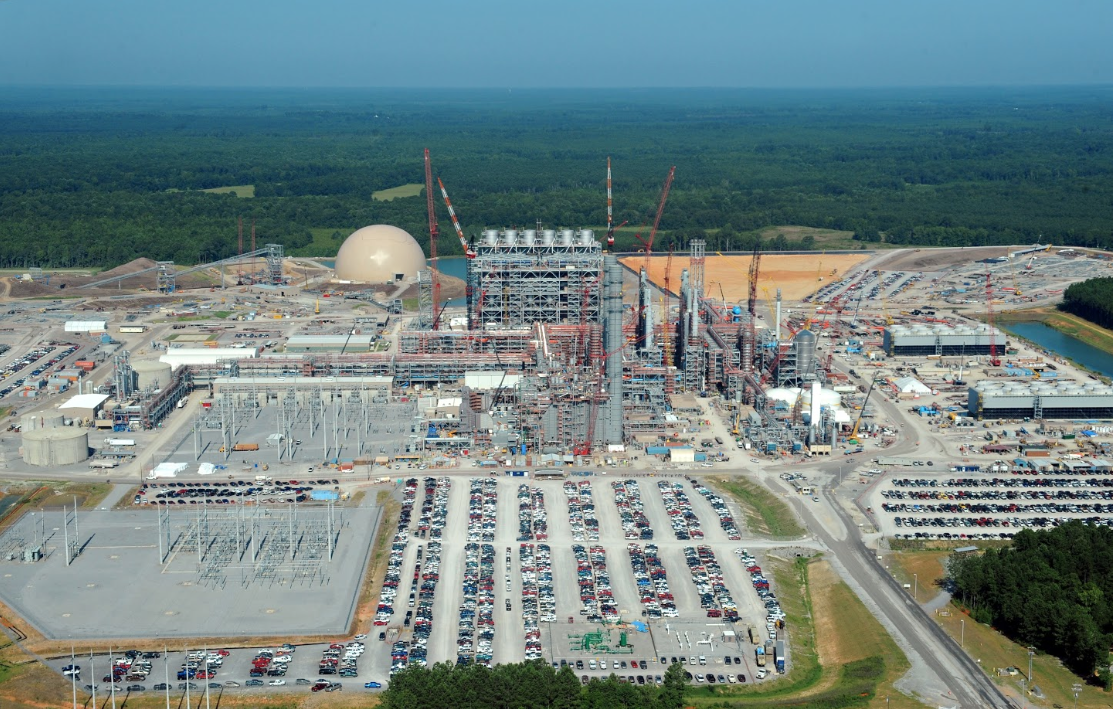The concept of “clean coal” was dealt a significant blow as Southern Company announced last week that it was suspending its coal gasification project in Mississippi.
The project was meant to be America’s flagship example for commercial-scale carbon capture and storage (CCS) technology. It was going to be a way to keep burning coal, except without the polluting carbon dioxide emissions.
The failure of this “clean coal” experiment has impacts beyond the US though as the world continues to wait for CCS technology to take off at scale.
CCS is the process of scrubbing carbon dioxide emissions from power plants and other industrial sources and storing them deep underground. The Kemper plant was attempting to use CCS in the power generation process as it converted coal into natural gas.
The plant has now gone from “clean coal” to dirty gas as it will operate solely as an a natural gas power producer. And, with an estimated total price tag of more than $7 billion, the project’s failure raises questions about the viability of CCS as a climate solution.
Two Degrees
A year and a half ago, the world agreed to limit warming to below 2°C under the Paris Agreement. A large part of being able to achieve this goal, however, relies on CCS technology.
According to the Intergovernmental Panel on Climate Change’s (IPCC) most recent projections, reaching a 2°C goal requires widespread deployment of CCS combined with bioenergy. By 2050, the IPCC projects CCS to be responsible for cutting 14 percent of the world’s carbon emissions.
As Glen Peters, senior researcher at the Center for International Climate and Environmental Research-Oslo (CICERO) in Norway, told DeSmog UK: “[Climate] models really struggle to stay below 2°C without CCS. Without CCS, it costs a lot more to stay below 2°C, if you can even keep below that temperature.”
Peters recently lead a study published in Nature Climate Change which found that the lack of development and deployment of CCS is the biggest challenge to meeting the Paris climate targets if countries failed to invest properly in CCS technology, limiting warming to “well below” 2°C might be impossible to achieve.
IPCC scenarios look at CCS on fossil fuels (including coal), industry (such as cement) and bioenergy. And in all of these scenarios, Peters says, “CCS is used at scale”.
“Some scenarios have CCS of about 40GtCO2/yr, or about the same magnitude of today’s CO2 emissions,” he says of the many, many different scenarios put together by the IPCC. “Some scenarios require scaling up with several, sometimes more than five, new CCS facilities every week for the rest of the century. This is large scale.”
“Overall, CCS is rather critical to keep below 2°C,” he continues. “Whether this is the reality depends on the models, modelling assumptions, model structure, and so on. The [IPCC] models did not spend a huge amount of effort looking at ways to keep below 2°C with lower amounts of CCS.”
“I would argue there is a large gap in the literature between no/low CCS and large-scale CCS as in the scenarios.”
Without CCS combined with bioenergy, the IPCC warns mitigations costs “can increase substantially” adding that the longer mitigation is delayed, the higher these costs will rise.
Ahead of the Paris climate conference in December 2015, 10 countries included using CCS as part of their strategy to cut emissions. This included China, Canada and Saudi Arabia.
Currently there are 38 large-scale CCS projects dotted around the globe according to the Global CCS Institute. But the majority of these are pilot projects. Together, these projects can capture about 40 million tonnes of CO2 per year (Mtpa). Compare this to the International Energy Agency’s figures which show that nearly 4,000 Mtpa must be captured in 2040 to meet the 2°C goal and the scale of the challenge becomes clear.
Scaling up
CCS is nowhere near close to operating at this scale. The technology has a long history of struggling to get off the ground and many question how ‘clean’ it actually is when it comes to reducing emissions from fossil fuel power plants.
In the UK, for example, there were two main CCS projects going forward in 2015 – Drax’s White Rose project and Shell’s Peterhead project. Both were finalists in the government’s CCS competition. However, in the run up to the COP21 Paris climate talks the competition’s £1 billion in funding was scrapped by the government and these projects came to a halt.
A lot of hopes were therefore pinned to Southern’s Kemper project – it was among three much-anticipated upcoming projects highlighted by the Global CCS Institute in its latest report. It’s failure to deliver is therefore a blow to many people’s idea that we can both keep burning coal and meet our climate targets.
As a Bloomberg editorial wrote: “‘Clean coal,’ always dubious as a concept and never proved as a reality, has now failed as a business proposition.”
Even coal CEO Robert Murray, as E&E reported, admitted as much last week when he said: “Carbon capture and sequestration does not work. It’s a pseudonym for ‘no coal’. It is neither practical nor economic, carbon capture and sequestration. It is just cover for the politicians, both Republicans and Democrats that say, ‘Look what I did for coal,’ knowing all the time that it doesn’t help coal at all.”
So does this mean we should forget about CCS as a solution? As it turns out, it’s not as simple as this question might suggest.
CCS and Industry
Speaking to DeSmog UK, Myles Allen, head of Oxford’s climate dynamics group, said: “[The Kemper news] does suggest that meeting the Paris goals while continuing to rely on coal for power generation (as many countries, not just the US, are doing) has had a set-back.”
But, Allen adds, this was just one approach to CCS and, he argues, “there are plenty of industrial processes like cement manufacture that still generate CO2 which will need to be disposed of. So, while this is a set-back for a particular approach to CO2 capture, it is completely irresponsible to use it … to suggest we should give up on the whole enterprise.”
Instead, the Kemper project failure suggests that “on a deeper level,” says Allen, “we are approaching the development of CCS the wrong way: thinking of carbon capture as a way to mitigate the emissions from a power plant, rather than a way to dispose of CO2 to compensate for digging up fossil carbon.”
“If we thought of it this second way,” he explains, “it would probably be many years, if ever, that we would fit CCS on coal (it might make more sense eventually not to burn coal for power generation at all), because there are plenty of much cheaper and more accessible ways of sourcing a clean CO2 stream for sequestration (either gas plants, or industrial processes) than capturing it from coal.”
CICERO’s Peters agrees: “Kemper has struggled, yes, but others have worked. Petra Nova [in Texas] is a recent example that worked. Kemper is a different type of CCS technology (pre-capture) which may explain some of the challenges, but some also claim poor management, etc., are bigger problems.”
Petra Nova – which began operations in January – captures the emissions post-combustion. They are then transported by pipeline for enhanced oil recovery – companies pump the captured CO2 into tapped-out oil fields to force out the remaining petroleum.
This is the same method used by Canada’s commercial-scale CCS project run by Sask Power’s Boundary Dam coal-fired station.
Of course, while this method captures carbon emissions, in the end they’re used to increase fossil fuel extraction.
“At the end of the day, the failure of one particular CCS plant should not mean much, but because of the bad connotations with CCS, it means more than it should,” Peters says of the view that for some environmentalists, using CCS is seen as excuse to keep burning fossil fuels and propping up a dying coal industry.
Many argue that the money invested in CCS is a waste given the high costs and low success rate. Instead, this money could be invested in renewables and other low-carbon technology.
But for other industries like steel or cement, where there might be no alternative way like there is for fossil fuels with renewables, CCS is likely going to be a necessary tool to reduce emissions. For coal though, it looks like the end of the road – it’s pretty hard to envision a future for the industry in a 2°C world with or without CCS.
CCS in the UK
What does all of this mean for the UK?
In 2016, Lord Deben, chairman of the government advisory body the Committee on Climate Change (CCC) wrote a letter to then climate and secretary Amber Rudd about CCS after the government scrapped all funding for the technology. It called for a renewed commitment to CCS, stating it is “of critical importance to meet the UK’s carbon targets at least cost”.
CCC head of carbon budgets, Mike Thompson told DeSmog UK that the CCC has published scenarios where the UK can meet its climate targets without CCS, “but these rely on full delivery of all other options and are expected to have considerably higher costs.”
It’s worth noting, however, that UK scenarios look towards gas-fired CCS as being the most cost effective over coal-fired CCS. Add to that the UK’s commitment to phase out unabated coal-fired power by 2025 and the failure of the Kemper plant doesn’t really impact the UK’s priorities Thompson explained. Coal continues to decline in Britain, making up less and less of the country’s power generation.
But, Thompson added: “Credibly starting a new approach to CCS will be a key test if the Clean Growth Plan [due in the fall] is to achieve its goal of putting the UK on track to meeting its climate targets.”
*Correction: In an earlier version, the quotes from the CCC were attributed to the wrong name; these have now been corrected.
Photo: Wikimedia Commons | CC 3.0
Subscribe to our newsletter
Stay up to date with DeSmog news and alerts






